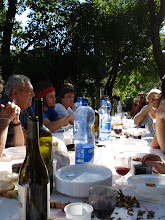www.vinoalvino.org/blog/2010/03/giu-le-mani-dalla-conca-d’oro-di-seggiano-un-mega-hotel-di-fronte-al-castello-di-potentino.html
http://www.sommelier.it/archivio.asp?ID_Categoria=9&ID_Articolo=1871
http://www.vinix.it/myDocDetail.php?ID=3881&lang=ita
Friday 26 March 2010
Invito al Convegno
INVITO AL CONVEGNO
PER LA TUTELA DELLA CONCA D'ORO
CASTELLO DI POTENTINO Seggiano SABATO 3 APRILE ORE 16,00
Invito a un dibattito pubblico
“Per la tutela della Conca d'Oro”
presso il Castello di Potentino - Seggiano www.potentino.com
Con interventi di rappresentanti nazionali di Italia Nostra, del “Comitato per la Valdorcia, Amiata e Crete Senesi”, WWF, operatori economici della zona
È stata invitata l'Amministrazione Comunale e la cittadinanza interessata.
Potentino in Peril
Now, after centuries untouched, it is under threat - a project for a well being centre about
500m from the castle and various other connected residential structures with asphalted access.
It is sadly only one example of what appears to be a symptomatic destruction of a historic rural heritage - the Val D'Orcia famous for its classic Tuscan look used in films like the ENGLISH PATIENT is also suffering from similar concrete invasions. Montepo, another wine estate owned by the Biondi Santi family has been completely surrounded by wind towers. Basically, local councils are short of money as EU grants and certain taxes are no longer designated to them, so they are merrily giving away remunerative permissions on the only resources they have left - the unique Tuscan landscape which the tourists come for and the very image which help sell its famous wine and food abroad. A very effective auto-destruction.
Friday 19 March 2010
"Organic" Wine
I saw this fascinating post in the New York Times Freakonomics Blog last week. It seems that labelling wine organic doesn't offer the price premium that it does with other organic products.
I have always had a bug bear about farming legislation which distinguishes between organic and conventional farming. The onus and expense of certification should be reversed where organic should be the default position rather than an expensive, bureaucratic choice.
The bureaucratic burden should be placed on the farmers who wish to use pesticides and fertilisers (whether organic or not) through the purchase of licences and taxed on the use of environmentally harmful products and there should be regular checks on all farmers to make sure that they are in compliance.
I would prefer to see a list of chemicals used on the produce I buy- a list of ingredients with their relative levels.
Wine should certainly not be excluded from this as I think most people would be horrified to know what goes into some of the more industrial "wine beverages" that are available on the lists of even the finest wine merchants.
I am certain that there is a kernal of an idea here- it isn't entirely practical and I am not convinced that this would always help inform the consumers' decisions, but the fact that a chicken can be pumped full of antibiotics (not on the label), plumped with all sorts of hydrogenated fats (on the label) and we still accept a bottle of wine that tells us nearly nothing, makes me wish I could raise one eye-brow...
Charlotte will have more to say on this I am sure!
I have always had a bug bear about farming legislation which distinguishes between organic and conventional farming. The onus and expense of certification should be reversed where organic should be the default position rather than an expensive, bureaucratic choice.
The bureaucratic burden should be placed on the farmers who wish to use pesticides and fertilisers (whether organic or not) through the purchase of licences and taxed on the use of environmentally harmful products and there should be regular checks on all farmers to make sure that they are in compliance.
I would prefer to see a list of chemicals used on the produce I buy- a list of ingredients with their relative levels.
Wine should certainly not be excluded from this as I think most people would be horrified to know what goes into some of the more industrial "wine beverages" that are available on the lists of even the finest wine merchants.
I am certain that there is a kernal of an idea here- it isn't entirely practical and I am not convinced that this would always help inform the consumers' decisions, but the fact that a chicken can be pumped full of antibiotics (not on the label), plumped with all sorts of hydrogenated fats (on the label) and we still accept a bottle of wine that tells us nearly nothing, makes me wish I could raise one eye-brow...
Charlotte will have more to say on this I am sure!
Thursday 4 March 2010
First Outing for The New Vintages and LYNCURIO's debut
www.acquabuona.it


Terre di Toscana 2010 - Terza edizione. 7 e 8 marzo a Lido di Camaiore
Terre di Toscana e i suoi territori. Maremma (grossetana), Lucchesia, Massese
Per finire, l’alta Maremma interna o, per riassumere in una parola, il Montecucco. Altro mondo, sebbene ci troviamo ancora in provincia di Grosseto. Le giaciture e i terreni sostanzialmente differenti, le condizioni climatiche in alcuni casi pedemontane, concorrono alla realizzazione di vini più freschi e contrastati che non quelli della Maremma classica. A Terre di Toscana saranno presenti tre campioni del territorio: Leonardo Salustri , che con l’aiuto del figlio Marco cura le vigne una a una per ricavarne dei sangiovese personalissimi e di grande energia, i Montecucco Grotte Rosse e Santa Marta. Castello di Potentino, con lo straordinario Montecucco Sacromonte, l’intrigante Piròpo (pinot nero in larga prevalenza, per ora in assemblaggio con sangiovese ed alicante), e con la nuova scommesa in bianco, chiamata Lyncurio, di cui siam certi si parlerà.
Subscribe to:
Posts (Atom)







